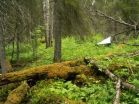Abstracts for these and other Geosphere papers are available at http://geosphere.gsapubs.org/. Representatives of the media may obtain complimentary copies of Geosphere articles by contacting Kea Giles at the address above.
Please discuss articles of interest with the authors before publishing stories on their work, and please make reference to Geosphere in articles published. Contact Kea Giles for additional information or assistance.
Non-media requests for articles may be directed to GSA Sales and Service, gsaservice@geosociety.org.
Introduction: The ANDRILL McMurdo Ice Shelf (MIS) and Southern McMurdo Sound (SMS) Drilling Projects
Timothy S. Paulsen et al., Dept. of Geology, University of Wisconsin Oshkosh, 800 Algoma Blvd., Oshkosh, Wisconsin 54901, USA. Posted online 17 May 2012; doi: 10.1130/GES00813.1.
GSA is pleased to introduce a new themed issue: The ANDRILL McMurdo Ice Shelf (MIS) and Southern McMurdo Sound (SMS) Drilling Projects. Some of the greatest uncertainties in our understanding of Cenozoic global tectonics and climate can be traced back to our relatively meager knowledge about Antarctica's continental lithosphere and its overlying continental glaciers. A trove of information about past tectonism and the behavior of the continental ice sheets lies buried along the submarine continental margins of Antarctica. In order to explore this area, there have been several international efforts over the last several decades to drill Cenozoic stratigraphic sequences within basins in the West Antarctic Rift system in the southern Ross Sea. The most recent of the Ross Sea drilling projects was part of the ANDRILL initiative (www.andrill.org) in which scientists from Germany, Italy, New Zealand, and the United States collaborated to acquire two high-resolution slim-hole sedimentary cores from the southern Ross Sea. The papers within this Geosphere themed issue examine results associated with these projects. They are ultimately a result of significant efforts by a new generation of scientists who were willing and able to take the reins of leadership at the close of ANDRILL's ancestor, the Cape Roberts Project. These papers speak to the importance of multidisciplinary science and international cooperation, and hopefully come at the dawn of further drilling and investigations of the scientific frontier represented by Antarctica's continental margins.
Lithosphere-asthenosphere mixing in a transform-dominated Late Paleozoic back-arc basin: Implications for northern Cordilleran crustal growth and assembly
Stephen J. Piercey et al., Dept. of Earth Sciences, Memorial University of Newfoundland, 300 Prince Phillip Drive, St. John's, NL, A1B 3X5, Canada. Posted online 17 May 2012; doi: 10.1130/GES00757.1.
This paper by Stephen J. Piercey and colleagues details an integrated field, rock, chemical, and radiogenic isotopic study of ancient oceanic rocks in southeastern Yukon, Canada: the Campbell Range formation of the Yukon-Tanana terrane. Piercey and colleagues provide new data and insight into the evolution of the northern Cordilleran mountain system in northern Canada. Their results illustrate that the rocks studied initially formed in a back-arc basin behind a Japan-like continental arc system, were subsequently transported to southern latitudes by large-scale lateral translation where they obtained distinctive fauna found only in the southwestern U.S., and were then finally transported back to northern latitudes near their present location. The results also illustrate that while these rocks represent new "juvenile" crustal material derived from the Earth's mantle, they do not represent abundant new crust formation because they are only thin layers atop a predominantly continental crustal substrate.
Deciphering the early history of a multiply reactivated fault using strain analysis in an adjacent fold: Evidence for early brittle-plastic slip on the Picuris-Pecos fault, New Mexico, USA
Amy Luther et al., Dept. of Earth and Environmental Science, New Mexico Institute of Mining and Technology, Socorro, New Mexico 87801, USA. Posted online 17 May 2012; doi: 10.1130/GES00776.1.
Precambrian shear zones and faults that cut continental basement rocks commonly are reactivated and control the location and orientation of younger structures. The initial history of a multiply reactivated fault can be very difficult to determine if younger brittle deformation strongly reorients the oldest strain markers. Amy Luther and colleagues use a new technique to find the initial age and kinematics of a large strike-slip fault using the strain history adjacent rocks integrated with previously published thermal age data. This method can be effective for faults with complex reactivation histories and well-known thermal histories.
Flat-topped mounds in western Ross Sea: Carbonate mounds or subglacial volcanic features?
L. Lawver et al., The University of Texas at Austin, Institute for Geophysics, Jackson School of Geoscience, 10100 Burnet Road, R2200, Austin, Texas 78758, USA. Posted online 17 May 2012; doi: 10.1130/GES00766.1.
Detailed multibeam bathymetry data in the western Ross Sea, Antarctica, delineate a field of unusual flat-topped seafloor mounds located ~50 km west of Franklin Island and an arcuate zone of pockmarks to the northwest and west of Franklin Island. Sixteen mounds occur in an area about 30 km square at a depth of ~500 m, within the Terror Rift, the active extensional part of the Victoria Land Basin. The mounds tend to be circular in the east and linear in the west, with their steepest slope to the southeast and shallowest slope to the northwest, consistent with erosion by northwest ice-sheet movement. The largest mound is ~4 km across and 100 m high. Five similar features were delineated to the south and east of Franklin Island at depths of 400-650 m. Seismic, gravity, and magnetic data indicate that the mounds are largely low-density, nonmagnetic bodies overlying a largely nondisrupted sedimentary section, but some mounds have an associated small (~50 nT), short-wavelength, normal or reversed magnetic anomaly, indicating a magnetic core to the mounds. Their proximity to inferred subsurface gas hydrates suggests they may be carbonate banks, but they also occur close to volcanic centers including Franklin Island. The preferred interpretation of authors L. Lawver and colleagues is that they are of volcanic origin, erupted during a geomagnetic reversal and under a grounded ice sheet forming hyaloclastite edifices, previously unknown under the Ross Sea. The pockmarks range from 200 m to 500 m in diameter.
###
www.geosociety.org
END


